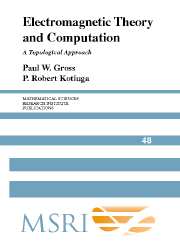Book contents
- Frontmatter
- Table of Contents
- Preface
- Introduction
- 1 From Vector Calculus to Algebraic Topology
- 2 Quasistatic Electromagnetic Fields
- 3 Duality Theorems for Manifolds With Boundary
- 4 The Finite Element Method and Data Structures
- 5 Computing Eddy Currents on Thin Conductors with Scalar Potentials
- 6 An Algorithm to Make Cuts for Magnetic Scalar Potentials
- 7 A Paradigm Problem
- Mathematical Appendix: Manifolds, Differential Forms, Cohomology, Riemannian Structures
- Bibliography
- Summary of Notation
- Examples and Tables
- Index
7 - A Paradigm Problem
Published online by Cambridge University Press: 06 July 2010
- Frontmatter
- Table of Contents
- Preface
- Introduction
- 1 From Vector Calculus to Algebraic Topology
- 2 Quasistatic Electromagnetic Fields
- 3 Duality Theorems for Manifolds With Boundary
- 4 The Finite Element Method and Data Structures
- 5 Computing Eddy Currents on Thin Conductors with Scalar Potentials
- 6 An Algorithm to Make Cuts for Magnetic Scalar Potentials
- 7 A Paradigm Problem
- Mathematical Appendix: Manifolds, Differential Forms, Cohomology, Riemannian Structures
- Bibliography
- Summary of Notation
- Examples and Tables
- Index
Summary
7A. The Paradigm Problem
The purpose of this chapter is to show how the formalism of differential forms reduces a broad class of problems in computational electromagnetics to a common form. For this class of problems, the differential complexes and orthogonal decompositions associated with differential forms make questions of existence and uniqueness of solution simple to answer in a complete way which exposes the role played by relative homology groups. When this class of problems is formulated variationally, the orthogonal decomposition theorem developed in Section MA-M generalizes certain well known interrelationships between gauge transformations and conservation laws (see [Ton68]) to include global conditions between dual cohomology groups. The orthogonal decomposition theorem can then be used to construct an alternate variational principle whose unique extremal always exists and can be used to obtain a posteriori measures of problem solvability, that is to verify if any conservation law was violated in the statement of the problem. A diagrammatic representation of the problem along the lines of [Ton72b] will be given and the role of homology groups will be reconsidered in this context. This of course will be of interest to people working in the area complementary variational principles.
In addition to the usual literature cited in the bibliography, the work of Tonti [Ton68, Ton69, Ton72b, Ton72a, Ton77], Sibner and Sibner [SS70, SS79, SS81] and [Kot82] have been particularly useful in developing the ideas presented in this chapter. From the view of computational electromagnetics, the beauty of formulating a paradigm variational problem in terms of differential forms is that the finite element method and Whitney form interpolation yield a discretization which faithfully reproduces all the essential features of the continuum problem.
Information
- Type
- Chapter
- Information
- Electromagnetic Theory and ComputationA Topological Approach, pp. 183 - 214Publisher: Cambridge University PressPrint publication year: 2004
